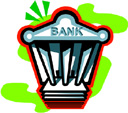What Banks Do
Part 1: Money In, Money Out A bank is, at its most basic, a place where money changes hands. Banks have as customers individuals, families, businesses, and even governments. Banks offer a wide array of services. No matter how much banks try to portray themselves as helpful businesses, they are still businesses, out to make money, just like any other business.
A savings account allows customers to deposit money into the account and leave it there until the money is needed again. Banks usually offer interest on savings accounts. Interest is a percentage of the sum of the account and is an incentive for customers to deposit their money in the bank instead of keeping it in a shoebox under the bed. The higher the interest rate, the more money a customer will get. Here's an example: You put $100 in a savings account. The account has an interest rate of 5 percent. At the end of the year, if you have put no more money into the account and you have not withdrawn any money, you will have $105, since the bank will have given you 5 percent of your $100 (and $100 + $5 = $105). A special kind of savings account results in the customer getting a certificate of deposit. The customer deposits a certain amount of money and agrees to withdraw it for a certain period of time (like 6 months or a year). The bank, in turn, agrees to pay a certain amount of interest at the end of that period of time. Interest rates on certificates of deposit (or CDs, at they are more commonly known) are usually higher than on regular savings accounts. When the period of time has passed, the customer is free to take the money back, with interest included.
Being able to keep money for an extended period of time enables a bank to ensure its money flow. Banks don't usually have on hand all the money in the accounts of every customer. In other words, if all the customers arrived at the bank at the same time and demanded all the money in all their accounts, the bank would probably not be able to produce all of that money. (This happened a lot in the late 1920s and early 1930s in America, as the country headed into the Great Depression.) That's because banks exchange money with other banks and with other financial institutions. Next page > Now You See It, Now You Don't > Page 1, 2 |
|
Social Studies for Kids
copyright 2002–2026
David White



 Banks give and take money from people and from businesses. Most people and most businesses have at least one bank account. The most common kinds of bank accounts are savings and checking.
Banks give and take money from people and from businesses. Most people and most businesses have at least one bank account. The most common kinds of bank accounts are savings and checking.  A checking account is used primarily to take money out of an account. People and businesses use checking accounts to pay bills. To pay those bills, customers will write checks to various people for specific amounts of money. A check is a piece of paper handwritten by the owner of the checking account. The check specifies how much money is to be taken out of the account and to whom the money is to be given. Checks are mailed or hand-delivered. To get the money, a person or business will "cash" the check, signing it over to the bank and directing the bank to take the money from the sender's checking account and deposit it into a designated account of the person or the business doing the "cashing." Someone who cashes a check can also receive cash (thus the name).
A checking account is used primarily to take money out of an account. People and businesses use checking accounts to pay bills. To pay those bills, customers will write checks to various people for specific amounts of money. A check is a piece of paper handwritten by the owner of the checking account. The check specifies how much money is to be taken out of the account and to whom the money is to be given. Checks are mailed or hand-delivered. To get the money, a person or business will "cash" the check, signing it over to the bank and directing the bank to take the money from the sender's checking account and deposit it into a designated account of the person or the business doing the "cashing." Someone who cashes a check can also receive cash (thus the name). 
